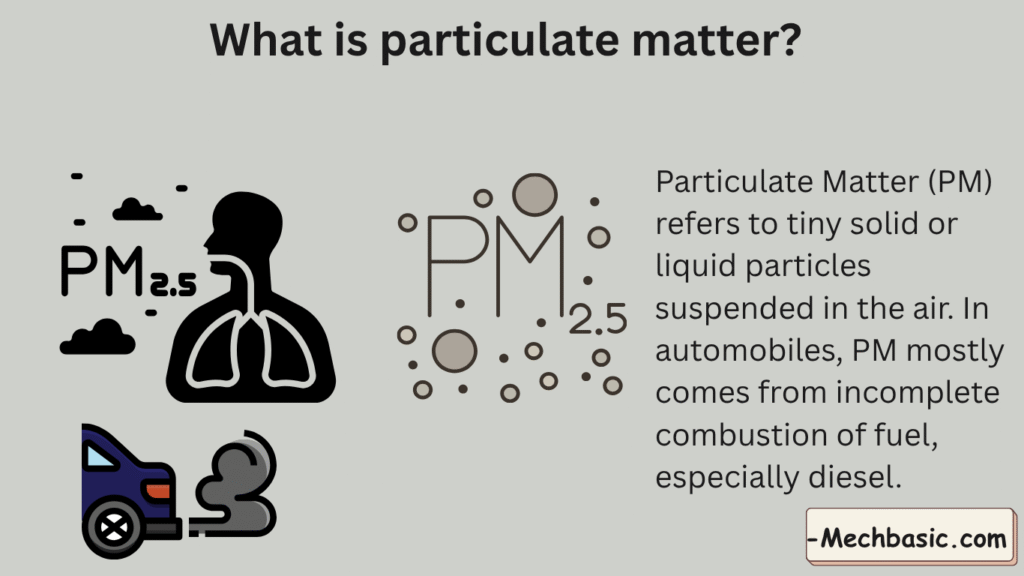Let’s go in detail about Particulate Matter (PM), especially in the context of automobile emissions.

In this article:
1. What is Particulate Matter (PM)?
Definition:
Particulate Matter (PM) refers to tiny solid or liquid particles suspended in the air. In automobiles, PM mostly comes from incomplete combustion of fuel, especially diesel.
Characteristics:
- Size: Ranges from coarse particles (>2.5 µm) to fine particles (<2.5 µm, PM2.5) and ultrafine particles (<0.1 µm).
- Composition: Carbon (soot), hydrocarbons, metals, sulfates, nitrates, and ash.
- Visibility: Can appear as black smoke from diesel engines.
2. Formation of Particulate Matter in Vehicles
A. Diesel (CI) Engines
- Main source of PM because diesel burns fuel under high compression but lean mixture.
- Incomplete combustion → carbon soot, adsorbed unburnt hydrocarbons, and sulfates.
- PM increases under:
- Low-speed operation
- High load
- Cold start
- Poor fuel atomization
B. Petrol (SI) Engines
- PM is much lower, but direct injection engines can emit ultrafine particles.
C. Evaporative PM
- Fuel evaporation and lubricating oil burning also contribute to PM.
3. Types of Particulate Matter
| Type | Size | Source | Remarks |
|---|---|---|---|
| Coarse PM (PM10) | 2.5–10 µm | Road dust, tire wear | Settles quickly, affects air quality |
| Fine PM (PM2.5) | <2.5 µm | Diesel combustion, gasoline direct injection | Can penetrate lungs deeply |
| Ultrafine PM (PM0.1) | <0.1 µm | Vehicle exhaust, nanoparticles | Can enter bloodstream, highly toxic |
| Black Carbon (Soot) | Variable | Diesel engines | Main contributor to global warming & air pollution |
4. Environmental and Health Effects
A. Health Effects
- Respiratory: Asthma, bronchitis, lung inflammation
- Cardiovascular: Heart attacks, stroke
- Chronic exposure: Lung cancer, reduced lung function
- Ultrafine PM: Can cross lung membranes and affect brain, heart, and kidneys
B. Environmental Effects
- Air pollution: Reduces visibility (smog, haze)
- Climate impact: Black carbon absorbs sunlight → global warming
- Soil & water contamination: Settles on surfaces and water bodies
5. Control of Particulate Matter in Automobiles
A. Engine Design
- Better fuel atomization: Complete combustion → fewer soot particles
- Optimized injection timing: Reduces incomplete combustion
- Turbocharging and intercooling: Lower PM emissions
B. After-Treatment Devices
- Diesel Particulate Filter (DPF)
- Traps PM from exhaust gas.
- Periodically burns collected soot at high temperatures (regeneration).
- Can reduce PM by up to 90–99%.
- Catalytic Converters
- Oxidizes some hydrocarbons and soot → CO₂ + H₂O
- More effective in gasoline engines
C. Fuel Quality
- Low-sulfur diesel → reduces sulfate PM formation
- Biodiesel blends → can reduce PM but may increase NOₓ slightly
6. PM in SI vs CI Engines
| Pollutant | SI Engine (Petrol) | CI Engine (Diesel) | Notes |
|---|---|---|---|
| PM (Soot) | Low | High | Diesel engines produce visible black smoke |
| PM2.5 / PM0.1 | Low | High | Ultrafine particles harmful to lungs |
| Source | Evaporation, misfire | Incomplete combustion, fuel-rich pockets |
7. Typical PM Levels
| Engine Type | Without Control | With DPF / Catalytic Converter |
|---|---|---|
| Diesel CI | 0.1–0.3 g/km | 0.004–0.01 g/km |
| Petrol SI | 0.005–0.01 g/km | <0.005 g/km |
8. Key Facts
- PM is not a single chemical, but a mixture of soot, hydrocarbons, metals, and sulfates.
- Diesel engines are the largest source in transportation.
- Health risk increases with particle size decrease → PM0.1 more dangerous than PM10.
- DPF regeneration requires proper driving conditions; otherwise soot buildup can damage the filter.
9. Summary Table
| Aspect | Details |
|---|---|
| Definition | Tiny solid or liquid particles from combustion |
| Chemical Composition | Carbon, hydrocarbons, metals, sulfates |
| Major Source | Diesel engines, fuel combustion |
| Health Effects | Respiratory, cardiovascular, cancer |
| Environmental Effects | Smog, global warming, soil/water contamination |
| Control Measures | Diesel Particulate Filter, Catalytic Converter, low-sulfur fuel, engine optimization |
In Short:
Particulate Matter (PM) is a mixture of soot, hydrocarbons, and other particles emitted mainly from diesel engines.
It pollutes air, damages human health, and contributes to global warming, but DPFs, catalytic converters, and cleaner fuels can drastically reduce PM emissions.
💡 Fun Fact:
A single modern diesel car without a DPF can emit billions of ultrafine particles in just one kilometer of driving!
FAQ Section:
Here are 10 frequently asked questions (FAQs) about Particulate Matter (PM):
- What is Particulate Matter (PM)?
Particulate Matter is a mixture of tiny solid particles and liquid droplets suspended in the air, such as dust, soot, and smoke. - What are the types of Particulate Matter?
PM is classified mainly by size: PM10 (particles ≤10 micrometers) and PM2.5 (particles ≤2.5 micrometers). - How is PM produced?
PM is produced from vehicle exhaust, industrial emissions, construction dust, burning of fossil fuels, and natural sources like pollen or wildfires. - Why is PM harmful to health?
Fine particles can penetrate lungs and bloodstream, causing respiratory problems, heart disease, and aggravating asthma. - Does PM affect the environment?
Yes, it contributes to air pollution, reduced visibility, acid rain, and climate effects. - How do vehicles contribute to PM?
Diesel engines, incomplete combustion, and tire or brake wear release soot and fine particles into the air. - Can PM be controlled or reduced?
Yes, using filters (like Diesel Particulate Filters), cleaner fuels, emission controls, and dust suppression methods can reduce PM emissions. - Is PM only a human-made pollutant?
No, PM can also come from natural sources such as volcanoes, dust storms, pollen, and sea spray. - How is PM measured?
PM is measured using air quality monitoring stations, filters, and specialized sensors to determine particle concentration in the air. - Why is PM2.5 more dangerous than PM10?
PM2.5 particles are smaller, can penetrate deeper into the lungs, enter the bloodstream, and cause more severe health effects.
Other courses:



